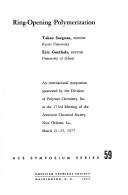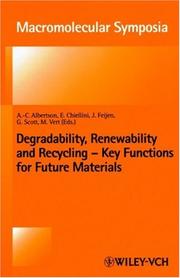| Listing 1 - 6 of 6 |
Sort by
|
Book
Year: 1969 Publisher: New York, NY : Marcel Dekker,
Abstract | Keywords | Export | Availability | Bookmark
 Loading...
Loading...Choose an application
- Reference Manager
- EndNote
- RefWorks (Direct export to RefWorks)

ISBN: 084120392X Year: 1977 Publisher: Washington, DC : ACS,
Abstract | Keywords | Export | Availability | Bookmark
 Loading...
Loading...Choose an application
- Reference Manager
- EndNote
- RefWorks (Direct export to RefWorks)

ISSN: 10221360 ISBN: 3527299041 9783527299041 Year: 1999 Volume: 144 Publisher: Weinheim: Wiley,
Abstract | Keywords | Export | Availability | Bookmark
 Loading...
Loading...Choose an application
- Reference Manager
- EndNote
- RefWorks (Direct export to RefWorks)
Polymers --- Plastics --- Plastic scrap --- Biodegradation --- Polymers - Biodegradation --- Plastics - Biodegradation --- Aliphatic polyesters --- Biodegradable polymers --- Chitin --- Decomposition --- Polysaccharides --- Recycling of polymeric materials --- Ring-opening polymerization
Dissertation

Year: 2016 Publisher: Liège Université de Liège (ULiège)
Abstract | Keywords | Export | Availability | Bookmark
 Loading...
Loading...Choose an application
- Reference Manager
- EndNote
- RefWorks (Direct export to RefWorks)
Le polylactide (PLA) est un polymère biosourcé, biodégradable et biocompatible, ce qui en fait un matériau en pleine expansion. Il est utilisé pour des applications de commodité telles que l’emballage ou des applications à plus haute valeur ajoutée telles que les systèmes de libération contrôlée de principes actifs ou encore la préparation d’échafaudages pour l’ingénierie tissulaire. Pour ce travail, l’octoate d’étain, catalyseur présentant une activité catalytique importante a été utilisé pour assurer une polymérisation par ouverture de cycle suffisamment rapide du L-lactide en PLLA de manière continue. Cette synthèse continue a été effectuée dans une extrudeuse bivis corotative présentant un diamètre de 11 mm et un ratio L/D de 40. Compte tenu de la petite taille de cette extrudeuse, divers arrangements de la configuration des vis et du fourreau ont dû être réalisés avec pour objectif d’augmenter le temps de résidence très limité dans le réacteur. Afin d’ensuite améliorer les propriétés du PLLA synthétisé, différentes modifications ont été apportées au mélange réactionnel : ajout d’un initiateur, d’un co-catalyseur, diminution de la quantité d’octoate d’étain. De plus, divers post-traitements ont également été réalisés. Il a finalement été possible de réaliser le PLLA avec une conversion moléculaire de 80000 g/mol et une polydispersité de 1,5 avec un rapport molaire catalyseur/monomère de 1/5000 et du polyéthylène glycol comme initiateur. Enfin, une analyse des risques liés aux défaillances possibles de l’extrudeuse a été réalisée dans l’’optique d’une mise à l’échelle industrielle du procédé de synthèse.
Book
Year: 2021 Publisher: Basel, Switzerland MDPI - Multidisciplinary Digital Publishing Institute
Abstract | Keywords | Export | Availability | Bookmark
 Loading...
Loading...Choose an application
- Reference Manager
- EndNote
- RefWorks (Direct export to RefWorks)
Creating antibacterial surfaces is the primary approach in preventing the occurrence and diffusion of clinical infections and foodborne diseases as well as in contrasting the propagation of pandemics in everyday life. Proper surface engineering can inhibit microorganism spread and biofilm formation, can contrast antimicrobial resistance (AMR), and can avoid cross-contamination from a contaminated surface to another and eventually to humans. For these reasons, antibacterial surfaces play a key role in many applications, ranging from biomedicine to food and beverage materials, textiles, and objects with frequent human contact. The incorporation of antimicrobial agents within a surface or their addition onto a surface are very effective strategies to achieve this aim and to properly modify many other surface properties at the same time. In this framework, this Special Issue collects research studying several materials and methods related to the antibacterial properties of surfaces for different applications and discussions about the environmental and human-safety aspects.
Technology: general issues --- nanocomposite --- mechanical properties --- cytotoxicity --- nanosilica --- antibiotics --- drug loading --- electrodeposition --- halloysite nanotubes --- zinc --- metal nanoparticles --- titanium implants --- cellulose --- silver --- nanoparticle --- antibacterial --- composite --- thin film --- xanthan gum --- zinc oxide --- quorum sensing --- biofilm --- virulence --- S. marcescens --- C. violaceum --- proteins --- titanium dioxide --- functionalization --- hybrid composites --- antimicrobial coatings --- aluminum-doped zinc oxide (AZO) --- RF sputtering (RFS) --- supersonic cluster beam deposition (SCBD) --- silver nanoparticles --- atomic force microscopy (AFM) --- health --- biomedical applications --- food packaging --- antibacterial coating --- antimicrobial peptide --- plasma polymer --- LL 37 --- Magainin --- Parasin --- bacterial attachment --- polylactide --- photodynamic --- supramolecular systems --- micelles --- drug delivery --- copolymers --- ring opening polymerization --- aPDT --- BODIPY --- antimicrobial --- polycaprolactone (PCL) --- nanofibers --- electrospinning --- sputtering --- antiviral --- biomedical --- bioremediation --- antifouling --- metal ions --- graphene --- antibiotic resistance --- foams --- biomaterials
Book
Year: 2022 Publisher: Basel MDPI - Multidisciplinary Digital Publishing Institute
Abstract | Keywords | Export | Availability | Bookmark
 Loading...
Loading...Choose an application
- Reference Manager
- EndNote
- RefWorks (Direct export to RefWorks)
Thermoresponsive polymers, materials able to undergo sharp and often reversible phase separations in response to temperature stimuli, are introducing new paradigms in different fields, including medicine, advanced separations and oil and gas. In "Advances in Thermoresponsive Polymers", a clear picture of the frontiers reached in the understanding of the mechanistic behavior associated with temperature-induced phase separation, the influence of the polymer structure in regulating the macroscopic behavior of these materials and the latest applications for which thermoresponsive polymers show great potential is provided.
Technology: general issues --- Chemical engineering --- poly(N,N-diethylacrylamide) --- glycidyl methacrylate --- thermoresponsive copolymer --- α-chymotrypsin --- polymer-enzyme conjugate nanoparticle --- polymeric nanoparticles --- emulsion polymerization --- RAFT --- thermo-responsive polymers --- smart materials --- LCST --- phase diagram --- phase separation --- thermoresponsive star-shaped polymers --- poly-2-alkyl-2-oxazines and poly-2-alkyl-2-oxazolines --- aqueous solutions --- light scattering --- turbidimetry --- microcalorimetry --- aggregation --- dual-stimuli-responsive materials --- thin films --- out-of-equilibrium --- thermoresponsive --- oligo(ethylene glycol) --- OEGylated --- poly(amino acid) --- ring-opening polymerization --- post-polymerization modification --- Ugi reaction --- synthesis --- star-shaped macromolecules --- calix[n]arene --- block and gradient copolymers of poly-2-alkyl-2-oxazolines --- conformation --- thermoresponsibility --- self-organization --- poly-N-vinylcaprolactam --- thermoresponsive polymers --- polymer-protein conjugates --- controlled release --- temperature-sensitive polymers --- hydrogels --- stereocomplexation --- polylactic acid --- temperature/reduction --- self-recombination --- thermosensitive polymers --- enzyme complexation --- reversible inactivation --- UCST polymers --- stimuli-responsive polymers --- electronic paramagnetic resonance --- spin probe --- nitroxides --- coil to globule --- poly(L-lysine) --- N-isopropylacrylamide --- aza-Michael addition reaction --- thermo-responsive --- pH-responsive --- biodegradable polymer
| Listing 1 - 6 of 6 |
Sort by
|

 Search
Search Feedback
Feedback About UniCat
About UniCat  Help
Help News
News